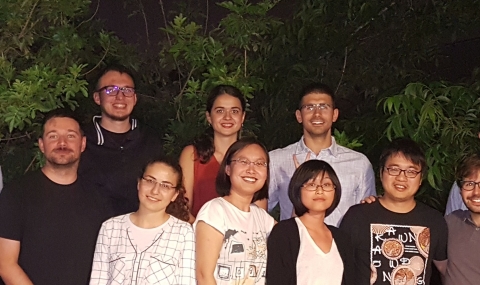New physics-based methods in magnetic resonance (quantum mechanical development of new pulse sequences, superoperator-based relaxation and exchange analyses), with applications to nuclear hyperpolarization, new tools in biophysical research (including SARS-CoV-2 RNA and protein binding studies), ultrahighfield preclinical research of function and development, and MRI-based methods for diagnosing pancreatic, breast and other cancers
Although inextricably linked to chemical physics, it is thanks to biophysical, biological and clinical applications the most remarkable progress in magnetic resonance –some of it driven by our own group’s NMR and MRI research– arises today. Our work includes the development of new methods for biosolids NMR; methods for sensitizing in vitro NMR and in vivo MRI using nuclear hyperpolarization; new pulse sequences for accelerating the acquisition of high-dimensional NMR and MRI data sets; new quantum-based techniques for detecting low-abundant species in NMR of proteins, glycans and nucleic acids; new molecular imaging approaches to tumor diagnosis in MRI. This research calls for synergies between physics, chemistry, computer sciences, biology and radiology; and it provides an immense array of theoretical and technical skill sets. While the inter- and cross-disciplinary nature of our projects prevents them from being divided into canonical classifications, we divide them into
- Research aimed at improving the NMR spectroscopy of solids, with special emphasis at enhancing resolution and sensitivity in materials and biomaterials studies. This research spans a scope of ideas and applications focusing in particular on quadrupolar (spin > ½) and low-g spins, in the hope to enable “Solids NMR Throughout the Periodic Table”
- In recent years we have established a serendipitous connection between solvents of labile protons with water, and experiments we carried out a decade ago when introducing quantum Zeno and anti-Zeno effects to NMR. Elaboration of such concepts is allowing us to achieve significant sensitivity enhancements in protein, nucleic acids and polysaccharides solution-state NMR. In fact, when over the course of the recent pandemics much of our non-Covid19 research was halted, we demonstrated time savings of ≥500-fold in NMR acquisitions of SARS-CoV-2 RNA fragments by these means: “Sensitivity Enhancement: Zeno to the Rescue”
- We developed a method for collecting arbitrary multidimensional NMR spectra and images in a single shot, reducing the duration of such experiments by orders of magnitude. Our multi-dimensional methods are unique in NMR, and complement Sir P. Mansfield’s Nobel-award-winning Echo Planar Imaging approach for single-shot 2D MRI. Our methods are being developed for NMR applications but, primarily, for in vivo MRI, as they enable animal and human studies –including clinical trials– based on diffusion and functional MRI, that are well beyond EPI’s imaging capabilities. This in vivo MRI portion of our research enables “MRI of Inaccessible Tissues and Organs”
- A main emphasis of our research centers on the field of nuclear hyperpolarization via metastable states. This suits us from multiple perspectives: Hyperpolarization is a perfect match to our single-shot 2D NMR methods; it opens new opportunities for in vivo studies; and it makes a natural complement to Zeno –if the water in question is hyperpolarized. Moreover, hyperpolarizing methods lying at the junction between EPR and NMR possess a fascinating spin physics that remains to be fully elucidated. As many of these methods concern solution-state applications, we title them “Taking the plunge: Hyperpolarizing molecules in the liquid state”
- Our interests in quadrupolar nuclei, hyperpolarization, and high field in vivo imaging and spectroscopy, find a natural point of contact in the use of hyperpolarized 13C and 2H as unique metabolic markers. Our aim is to transform these low-g species into “Metabolic MRI: Our next PET”



